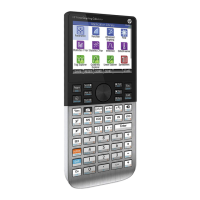
Do you have a question about the HP Prime Graphing Calculator and is the answer not in the manual?
| Type | Graphing Calculator |
|---|---|
| Resolution | 320 x 240 pixels |
| Power | Rechargeable lithium-ion battery |
| Display | 3.5-inch color LCD touchscreen |
| Memory | 32 MB RAM, 256 MB Flash |
| Connectivity | USB |
| Operating System | HP Prime Operating System |
| Dimensions | 18.23 x 8.58 x 1.39 cm |
| Supported Applications | Spreadsheet, Geometry, Advanced Graphing |
| Programming Languages | HP PPL (HP Prime Programming Language) |
| Weight | 228 grams |
Learn how to charge the HP Prime calculator's battery fully before first use.
Understand the HP Prime's Home view, its sections, and the on-screen elements.
Explore user-configurable settings like angle measure, number format, and entry method.
Learn methods for entering and editing mathematical expressions and text on the calculator.
Navigate and interact with the HP Prime's interface, including menus, boxes, and fields.
Introduction to HP apps, their purpose, and how to launch them from the Application Library.
Description of Symbolic, Plot, and Numeric views common to most HP Prime applications.
Overview of primary apps like Function, Advanced Graphing, Parametric, Polar, and Sequence.
Solve time-value-of-money (TVM) and amortization problems using the Finance app.
Solve systems of linear equations (2x2 and 3x3) using the Linear Solver application.
Calculate triangle side lengths and angle sizes using the Triangle Solver app.
Explore function behavior and graph changes by manipulating parameters in Explorer apps.
Explore sinusoidal equations and their graphs by changing parameters in the Trig Explorer.
Learn to create custom app instances based on built-in apps for personalized use.
Access mathematical functions arranged by category in the Math Toolbox menu.
Explore CAS functions for symbolic calculations, arranged by category in the CAS menu.
View and access user-defined functions, programs, and created objects from the User menu.
Create, modify, and manage lists of numbers, expressions, and matrices using the List Catalog.
Create and edit matrices and vectors using the Matrix Catalog and its dedicated editor.
Create, edit, run, and debug programs using the Program Catalog and its editor.